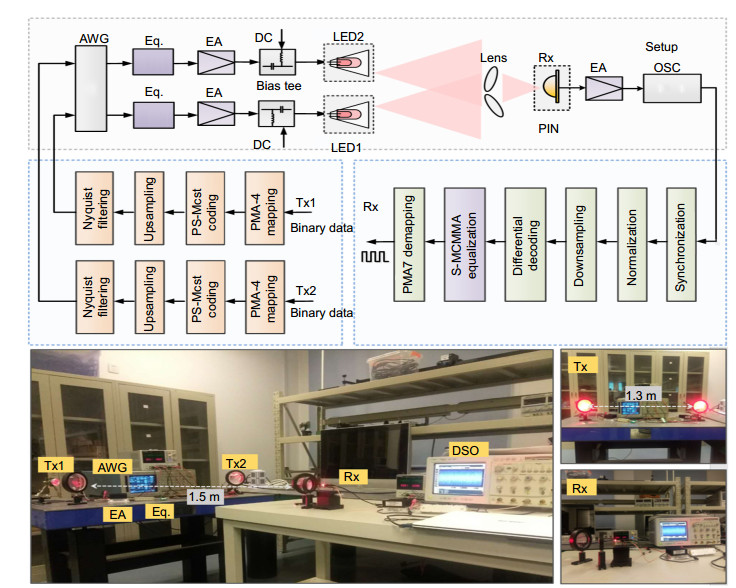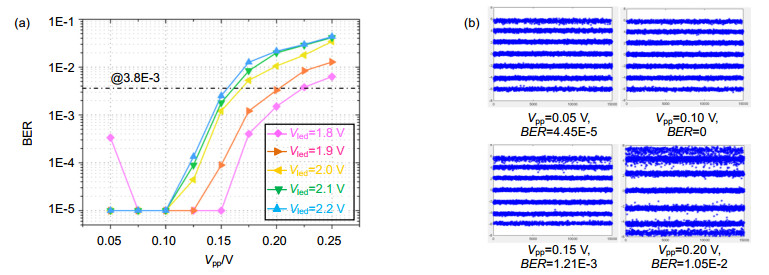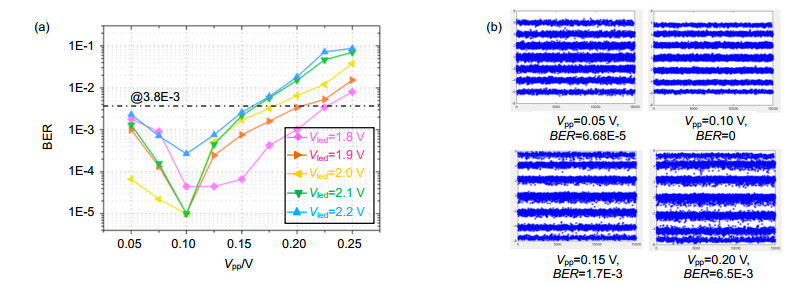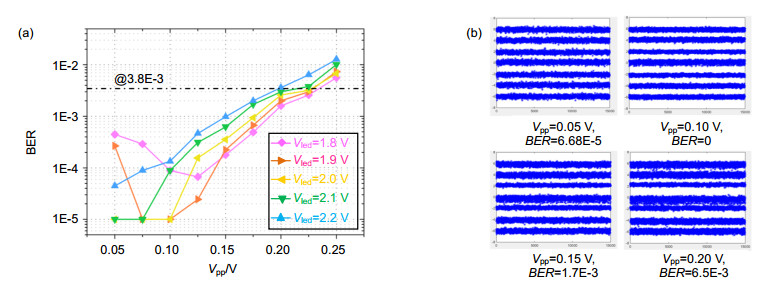Two input one output visible light communication system based on pulse amplitude modulation
-
摘要:
为了提高传统点对点单输入单输出(SISO)可见光系统的传输速率,提出了多输入多输出(MIMO)的可见光系统。考虑到接收端系统复杂度的问题,多输入单输出(MISO)可见光通信系统则更受关注。本文研究了基于脉冲幅度调制(PAM)的MISO可见光通信系统,并通过实验证明该系统在特定场景中的运用优势。此外,针对可见光通信系统中LED光源、功率放大器等关键器件存在非线性效应,本文基于两发一收的2×1 MISO可见光通信系统,设计了两路低阶PAM信号在光域叠加产生高阶PAM信号的新型的等概率编码映射方案,并通过RGB-LED的红灯完成净比特速率700 Mb/s的传输实验系统验证,证明了此方案在实际中的可行性及优越性。
 Abstract:
Abstract:To improve the data transmission rate of the conventional point-to-point single input single output (SISO) visible light communication system, a multiple input multiple output (MIMO) visible light communication system is proposed. Considering the complexity of the receiver system, multiple input single output (MISO) visible light communication systems have attracted attention. This paper studies the MISO visible light communication system based on pulse amplitude modulation (PAM), and experimentally proves the advantages of this system in specific scenes. In addition, there are non-linear effects for key devices such as LED light sources and power amplifiers in visible light communication systems. Based on 2×1 MISO visible light communication system, this paper reports a novel equal probability coding mapping scheme for high-order PAM signals with two low-order PAM signals superposition in the optical domain. The system verification is performed through a net data-rate of 700 Mb/s transmission experiment through a red chip of RGB-LED, which proves the feasibility and superiority of this scheme in practice.
-

Overview: To improve the data transmission rate of the conventional point-to-point single input single output (SISO) visible light communication system, a multiple input multiple output (MIMO) visible light communication system is proposed. Considering the complexity of the receiver system, multiple input single output (MISO) visible light communication systems have attracted attention.
In addition, in the VLC system, a series of key devices such as LED light sources and power amplifiers have nonlinear effects, and the nonlinear distortion of the system would damage the system performance. The nonlinearity of the LED modulation curve is the main source of nonlinearity in the VLC system. The visible light signal is mainly modulated in the linear region of the LED to reduce the signal damage caused by nonlinear distortion. However, at this time, the luminous efficiency of the LED is low, and the illumination brightness generally cannot meet the lighting requirements of the actual application scene. What’s more, for high-order modulation signals, the peak-to-average power ratio (PAPR) of the signal is higher due to an increase in the number of signal levels, and is more susceptible to system nonlinearity. Therefore, in the MISO system, multiple LED lights can be used to transmit signals at the same time, low-order signals are modulated on each lamp, and high-order signals are generated by superposition of optical signals to resist nonlinear distortion of the LED at the transmitter. The simultaneous light emission of multiple LED lights can also increase the brightness of the lighting to meet the actual lighting requirements.
This paper studies the MISO visible light communication system based on pulse amplitude modulation (PAM), and proves the advantages of using this system in specific scenes by experiment. Based on 2×1 MISO visible light communication system, a novel equal probability coding mapping scheme for high-order PAM signals with two low-order PAM signals superposition in the optical domain is designed. In the experiment, we investigated and compared the BER performance under different bias tee voltage and Vpp for four systems which are single-input-single-output generation PAM7 signals with equal probability and unequal probability, two-input-one-output generation PAM7 signals with equal probability and unequal probability, respectively. The experimental results show that the scheme we proposed, for generating equal-probability PAM7 signals in 2×1 MISO system with the large average Euclidean distance between symbols and a lower PAPR, can effectively resist the inter-symbol interference and the nonlinear distortion of LEDs and enlarge the dynamic working area of the system. Finally, the system verification is performed through a net data-rate of 700 Mb/s transmission experiment utilizing a red chip of RGB-LED, which proves the feasibility and superiority of this scheme in practice.
-

-
图 7 系统动态工作范围比较。(a)单发单收发射端生成不等概率PAM7;(b)单发单收发射端生成等概率PAM7;(c)两发一收接收端生成接收不等概率PAM7;(d)两发一收接收端接收生成等概率PAM7
Figure 7. The comparison of system's dynamic working area. (a) Unequal probability PAM7 signal at transmitter in SISO system; (b) Equal probability PAM7 signal at transmitter in SISO system; (c) Unequal probability PAM7 signal at receiver in two input one output system; (d) Equal probability PAM7 signal at receiver in two input one output system
表 1 四种PAM信号的PAPR
Table 1. The PAPR of four PAM signals
Signal Equal probability PAM4 Unequal probability PAM4 Equal probability PAM7 Unequal probability PAM7 PAPR 1.80 1.34 2.25 3.6 -
[1] Zeng L B, O'Brien D C, Le Minh H, et al. High data rate multiple input multiple output (MIMO) optical wireless communications using white LED lighting[J]. IEEE Journal on Selected Areas in Communications, 2009, 27(9): 1654–1662. doi: 10.1109/JSAC.2009.091215
[2] Mesleh R, Mehmood R, Elgala H, et al. Indoor MIMO optical wireless communication using spatial modulation[C]//Proceedings of 2010 IEEE International Conference on Communications, 2010: 1–5.
[3] Yu Z H, Baxley R J, Zhou G T. Multi-user MISO broadcasting for indoor visible light communication[C]//Proceedings of 2013 IEEE International Conference on Acoustics, Speech and Signal Processing, 2013: 4849–4853.
[4] Qian H, Yao S J, Cai S Z, et al. Adaptive postdistortion for nonlinear LEDs in visible light communications[J]. IEEE Photonics Journal, 2014, 6(4): 7901508. doi: 10.1109/JPHOT.2014.2331242
[5] 王灿, 周盈君, 迟楠.可见光通信中抗非线性方法的比较研究[J].中国照明电器, 2017(7): 9–15, 26. doi: 10.3969/j.issn.1002-6150.2017.07.002
Wang C, Zhou Y J, Chi N. Research of LED's nonlinear distortion compensation algorithm in visible light communications[J]. China Light & Lighting, 2017(7): 9–15, 26. doi: 10.3969/j.issn.1002-6150.2017.07.002
[6] Zhang M J, Shi M, Wang F M, et al. 4.05-Gb/s RGB LED-based VLC system utilizing PS-Manchester coded Nyquist PAM-8 modulation and hybrid time-frequency domain equalization[C]//Proceedings of the Optical Fiber Communication Conference, 2017: 1–3.
-


 E-mail Alert
E-mail Alert RSS
RSS
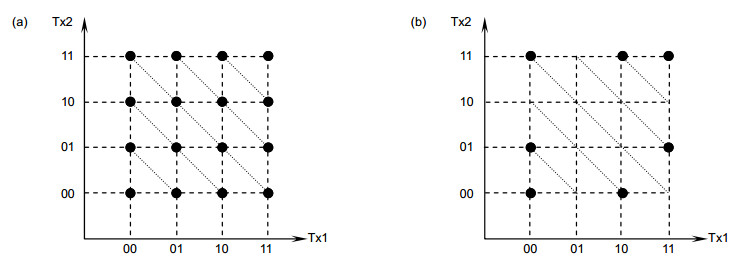
 下载:
下载:
